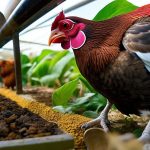Integrating turkeys with chickens can be a beneficial practice for poultry keepers. While turkeys and chickens can successfully share living quarters and develop social connections, it is essential to consider several factors when combining these species. This article examines the key aspects of keeping turkeys and chickens together, including:
1.
Physiological and behavioral differences between turkeys and chickens
2. Housing requirements and modifications for mixed flocks
3. Nutritional needs and feeding strategies
4.
Health management and disease prevention
5. Social dynamics and behavioral interactions
6. Best practices for introducing turkeys to an established chicken flock
By addressing these topics, poultry keepers can make informed decisions and create an environment that promotes the well-being of both turkeys and chickens in a mixed flock setting.
Table of Contents
- 1 Understanding the Differences Between Turkeys and Chickens
- 2 Coop and Run Considerations for Turkeys and Chickens
- 3 Feeding and Nutrition for Turkeys and Chickens
- 4 Health and Disease Management for Mixed Flocks
- 5 Behavior and Social Dynamics of Turkeys and Chickens
- 6 Tips for Integrating Turkeys into an Existing Chicken Flock
- 7 FAQs
- 7.1 What are the benefits of keeping turkeys with chickens?
- 7.2 What are some considerations when keeping turkeys with chickens?
- 7.3 What should be the housing requirements for turkeys and chickens kept together?
- 7.4 What should be the dietary considerations for turkeys and chickens kept together?
- 7.5 What are some potential challenges of keeping turkeys with chickens?
Key Takeaways
- Keeping turkeys with chickens can be a rewarding experience, but it requires careful consideration and planning.
- Turkeys and chickens have different needs and behaviors, so it’s important to understand their differences before keeping them together.
- When designing a coop and run for mixed flocks, it’s important to consider the space and amenities needed for both turkeys and chickens.
- Feeding and nutrition for turkeys and chickens can vary, so it’s important to provide appropriate food for each species to ensure their health and well-being.
- Managing the health and disease of mixed flocks requires regular monitoring and preventative measures to keep both turkeys and chickens healthy.
Understanding the Differences Between Turkeys and Chickens
Size and Physical Characteristics
Turkeys are larger and more robust than chickens, with adult males (toms) weighing up to 30 pounds or more. Chickens, on the other hand, are smaller and more agile, with adult roosters typically weighing around 8 pounds.
Dietary and Housing Requirements
Turkeys also have different dietary and housing requirements compared to chickens. While both species are social animals, turkeys tend to be more territorial and can be aggressive towards smaller birds like chickens. Understanding these differences is crucial for successfully integrating turkeys into a mixed flock.
Vocalizations and Behaviors
Turkeys also have different vocalizations and behaviors compared to chickens. Turkeys are known for their distinctive gobbling calls, while chickens communicate through clucking and crowing. Additionally, turkeys have a different social structure than chickens, with dominant toms establishing a pecking order within the flock.
Creating a Harmonious Environment
It’s important to be aware of these differences in order to create a harmonious living environment for both turkeys and chickens.
Coop and Run Considerations for Turkeys and Chickens

When keeping turkeys with chickens, it’s important to provide adequate housing and living space for both species. Turkeys require more space than chickens due to their larger size and territorial nature. A good rule of thumb is to provide at least 10 square feet of indoor space per turkey, and 4 square feet per chicken.
Additionally, turkeys need higher roosts and wider doorways compared to chickens, so the coop should be designed to accommodate their specific needs. The outdoor run should also be spacious enough to allow both turkeys and chickens to roam freely without feeling crowded. Providing ample space can help reduce aggression and competition between the two species.
It’s also important to provide separate nesting areas for turkeys and chickens, as they have different nesting habits and preferences. By creating a well-designed coop and run that meets the needs of both turkeys and chickens, you can create a harmonious living environment for your mixed flock.
Feeding and Nutrition for Turkeys and Chickens
Feeding a mixed flock of turkeys and chickens requires careful consideration of their dietary needs. While both species can eat a similar diet of grains, seeds, fruits, and vegetables, turkeys have higher protein requirements compared to chickens. A turkey-specific feed with at least 20% protein is recommended for optimal growth and health.
Additionally, turkeys require higher levels of certain vitamins and minerals, such as calcium and phosphorus, to support their larger size and rapid growth. It’s important to provide separate feeding stations for turkeys and chickens to prevent competition and ensure that each bird gets the nutrition they need. This can help reduce aggression and pecking order disputes over food.
Providing access to fresh water at all times is also crucial for both turkeys and chickens. By carefully managing the feeding and nutrition of your mixed flock, you can promote healthy growth and development for both turkeys and chickens.
Health and Disease Management for Mixed Flocks
Maintaining the health of a mixed flock of turkeys and chickens requires proactive disease management and biosecurity measures. Turkeys are susceptible to different diseases compared to chickens, so it’s important to be aware of the specific health risks for each species. For example, turkeys are more prone to respiratory diseases such as Mycoplasma gallisepticum, while chickens are more susceptible to coccidiosis.
Implementing biosecurity measures such as quarantine protocols for new birds, regular health checks, and vaccination programs can help prevent the spread of disease within the flock. It’s also important to keep the coop and run clean and well-ventilated to reduce the risk of disease transmission. By staying vigilant about the health of your mixed flock and taking proactive measures to prevent disease, you can help ensure the well-being of both turkeys and chickens.

Turkeys have a different social structure compared to chickens, with dominant toms establishing a pecking order within the flock. It’s essential to provide enough space and resources to prevent aggression and competition between birds.
Reducing Conflicts and Territorialism
Additionally, providing multiple roosting areas can help reduce conflicts over territory. By doing so, you can minimize the risk of aggressive behavior and bullying between birds.
Observing and Adjusting
Observing the behavior of your mixed flock can also help you identify any potential issues or conflicts that may arise. For example, aggressive behavior or bullying between birds may indicate that adjustments need to be made to the living environment or feeding arrangements. By being attentive to these signs, you can make the necessary changes to ensure a peaceful coexistence.
Tips for Integrating Turkeys into an Existing Chicken Flock
Integrating turkeys into an existing chicken flock requires careful planning and consideration of the needs of both species. It’s important to introduce turkeys to the flock at a young age, ideally as poults raised alongside chicks. This can help promote bonding between the two species and reduce the risk of aggression or territorial disputes.
Providing multiple feeding stations, roosting areas, and nesting spaces can also help reduce competition and conflicts between turkeys and chickens. It’s important to monitor the behavior of the birds closely during the integration process and make adjustments as needed to promote a peaceful coexistence. Additionally, providing environmental enrichment such as perches, dust bathing areas, and foraging opportunities can help reduce boredom and aggression within the flock.
By following these tips for integrating turkeys into an existing chicken flock, you can create a harmonious living environment for both species. In conclusion, keeping turkeys with chickens can be a rewarding experience for poultry enthusiasts. By understanding the differences between turkeys and chickens, providing adequate housing and living space, managing feeding and nutrition, maintaining health and disease management, understanding behavior and social dynamics, and following tips for successful integration, you can create a harmonious living environment for your mixed flock of turkeys and chickens.
With careful planning and consideration of the needs of both species, you can enjoy the unique personalities and interactions of these fascinating birds in your own backyard.
If you’re interested in learning more about keeping turkeys with chickens, you may also want to check out this article on chicken coop run plans. It provides valuable information on creating a safe and spacious environment for your poultry to roam and interact. This can be especially helpful when considering the unique needs of both turkeys and chickens living together.
FAQs
What are the benefits of keeping turkeys with chickens?
Keeping turkeys with chickens can provide several benefits, including pest control, increased flock diversity, and potential for improved flock health through natural foraging behaviors.
What are some considerations when keeping turkeys with chickens?
When keeping turkeys with chickens, it’s important to consider the size and temperament of the birds, as well as their specific housing and dietary needs. Additionally, biosecurity measures should be in place to prevent the spread of diseases between the two species.
What should be the housing requirements for turkeys and chickens kept together?
The housing for turkeys and chickens kept together should provide ample space for both species, with separate roosting areas to prevent potential aggression. Additionally, the housing should be secure to protect the birds from predators.
What should be the dietary considerations for turkeys and chickens kept together?
Turkeys and chickens have different dietary requirements, so it’s important to provide a balanced diet for both species. This may involve offering separate feeders for each species, as well as providing access to natural foraging opportunities.
What are some potential challenges of keeping turkeys with chickens?
Some potential challenges of keeping turkeys with chickens include potential aggression between the two species, as well as the risk of disease transmission. Additionally, turkeys may require different management practices, such as higher roosting areas and different nesting preferences.
Meet Walter, the feathered-friend fanatic of Florida! Nestled in the sunshine state, Walter struts through life with his feathered companions, clucking his way to happiness. With a coop that’s fancier than a five-star hotel, he’s the Don Juan of the chicken world. When he’s not teaching his hens to do the cha-cha, you’ll find him in a heated debate with his prized rooster, Sir Clucks-a-Lot. Walter’s poultry passion is no yolk; he’s the sunny-side-up guy you never knew you needed in your flock of friends!







